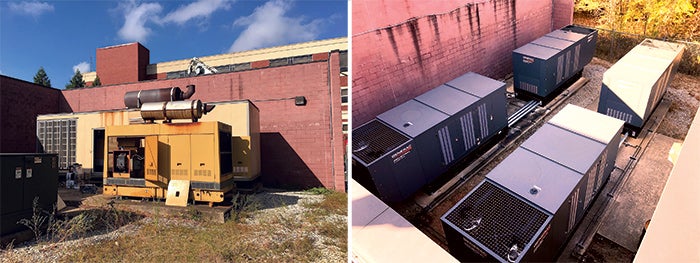Upgraded emergency power solves compliance and growth needs

By replacing an outdated backup power system (left) with new generator sets (right), Piedmont Newton was able to meet Joint Commission standards.
Since its service to the Newton County community began more than 60 years ago, Piedmont Newton Hospital, Covington, Ga., has expanded its footprint through the years to meet the needs of its growing population. Additional expansion is planned.
Between the ongoing growth of the 97-bed, 304,161-square-foot hospital and its role as a foundation in the community, facility staff decided it was time to upgrade and increase its emergency power.
To find a solution, Piedmont partnered with industrial generator supplier Energy Systems Southeast (ESSE) LLC, Birmingham, Ala., to evaluate its backup power needs and to specify new equipment. Jared Pierson, sales manager, ESSE, recommended installation of four 600-kilowatt, diesel-powered modular paralleling systems (MPS) from Generac Power Systems Inc., Waukesha, Wis.
“The current building load was nearing 1 megawatt, with plans for future growth and expansion,” Pierson says about the hospital. “The four times 600 kw configuration of backup generators offers n+2 redundancy on their current building load with n+1 redundancy as the hospital continues to grow.”
In addition to the redundancy and expandability built into the system, each generator set features onboard paralleling capabilities that make it easy to achieve an n+1 or greater power supply without the need for space-consuming and costly paralleling switchgear.
The MPS solution is also scalable, allowing kilowatt outputs to be tailored to unique requirements, making it a simple solution for critical care facilities that are looking to expand in the future.
With the addition of the new generator sets, Piedmont Newton was able to meet Joint Commission standards for minimum emergency power load and duration requirements. The solution also provided a remote monitoring system by OmniMetrix LLC, Buford, Ga., that determines generator power status in real time to meet Joint Commission regulations for testing and reporting.
Along with accurate monitoring, the new unit installation also will result in cost savings for the facility, specifically when it comes to testing the units for maintenance needs.
“Preventive maintenance and load bank testing will no longer require a roll-up mobile generator to provide backup power during the testing while the generator is offline, as it did for their old backup system,” Pierson says. “The new configuration will have the capacity to allow testing of the units while they remain online.”
The commissioning of the units was completed in early November, and the units have been in operation since.
“As with any project of this magnitude, it did not come without challenges that required quick thinking and resolution,” says Adam Woodall, service manager, ESSE. “From upgrading the switchgear operation, to the installation of the two paralleling units and the new fuel tanks, to the smaller projects like the additional micron filters, we oversaw the entire electrical and mechanical installation.”
Duke McNary, director of engineering, Piedmont Newton Hospital, credits ESSE with helping the hospital to find the right solution for its backup power needs. “They are always willing to help us with any problems, day or night, and even if it isn't their equipment. We are very satisfied with the professionalism, quality of installations and service of their work,” McNary says.
Jeff Ferenc is senior editor of Health Facilities Management.




